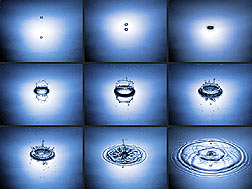Splashes, splashes and more splashes!
Photographs of high speed events have been a fascinating activity for photographers ever since Henry Fox Talbot used a spark gap to light up a page of the London Times placed on a rapidly whirling turntable and produced a sharp reproduction of it in 1840. A.M. Worthington's high speed photographs made in the late 1800's of projectile impact studies also made with spark illumination controlled by very simple and ingenious timing devices are a testament to his creativity and resourcefulness in an era when electronics was in its infancy.
In the 1930s Harold Edgerton recognized the potential of the spark gap and the electronic flash and refined these to highly controllable and precise sources of illumination for capturing on film a variety of high speed events. Most famous among these are probably his photographs of splashes. Especially those made by milk on a shallow pool or layer of the same or different liquid.
Making photographs of splashes is difficult because their lifetime is very brief and timing issues become a major problem. Splashes require very short exposure times if one is to capture a blur free final image. Required exposure times to prevent blur can be readily achieved today with electronic flashes operating at about 1/25,000 second. Many automatic flashes or flashes equipped with variable power controls can achieve such short times albeit giving up power in the process. Fortunately power is not a major issue when whatever power is available does not have to illuminate a large area. In splash photography the light source can be located fairly close to the subject since it rarely exceeds a few centimeters in size.
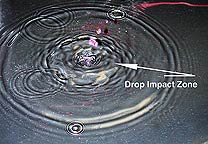 Firing the flash at the correct moment in relationship to the lifetime of a splash ultimately becomes the major obstacle to effective splash photography. Although many photographers have succeeded in manually tripping the camera shutter or a flash to capture splashes this is a very unpredictable approach and leads to an inordinate amount of photographs taken at the wrong time. Either too early or too late in the process.
Firing the flash at the correct moment in relationship to the lifetime of a splash ultimately becomes the major obstacle to effective splash photography. Although many photographers have succeeded in manually tripping the camera shutter or a flash to capture splashes this is a very unpredictable approach and leads to an inordinate amount of photographs taken at the wrong time. Either too early or too late in the process.
What is required is some means for detecting the splash or, preferably, the onset of a splash and having the capability to delay the flash a variable length of time that will cause the exposure to happen when the splash has achieved desired visual characteristics.
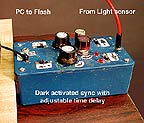 To make splash photographs on a predictable basis I devised a "Dark Activated Synchronizer" with delay capability. The function of the synchronizer is to close a switch a certain period of time after a light beam aimed at its photocell is interrupted. It behaves in a manner reminiscent of people counters or alarms in stores but instead of ringing a bell instantly as one enters the store it "delays" the bell for a variable length of time.
To make splash photographs on a predictable basis I devised a "Dark Activated Synchronizer" with delay capability. The function of the synchronizer is to close a switch a certain period of time after a light beam aimed at its photocell is interrupted. It behaves in a manner reminiscent of people counters or alarms in stores but instead of ringing a bell instantly as one enters the store it "delays" the bell for a variable length of time.
The synchronizer is based on a 556 timer IC device with a few odd and ends thrown in. The cost of the whole device is about $40-25 or less depending on the quality of the items purchased. The schematic of the circuit is available below. I must admit that there are a few bugs I have yet not resolved but we have been building these with my students for many years now and most of the time they perform very well. If you have an improvement you want to suggest I'd be more than happy to receive such guidance. Just drop me an email at the address below.
Otherwise, there are commercial synchronizer and delay units available on the market. Some of the manufacturers are listed at the bottom of this article.
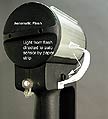 The switch of the synchronizer is used to fire the flash aimed at the pool where the splash will occur and onto which the camera lens has been prefocused. In order to achieve a short duration flash with an automatic flash unit a small piece of white paper can be attached to the flash head to redirect the light to the light sensor built into the flash somewhere. Durations in the order of 1/10,000 to 1/50,000 second are possible with this approach. If you have a flash with a manual power control selecting the lowest power level will also insure the shortest flash duration.
The switch of the synchronizer is used to fire the flash aimed at the pool where the splash will occur and onto which the camera lens has been prefocused. In order to achieve a short duration flash with an automatic flash unit a small piece of white paper can be attached to the flash head to redirect the light to the light sensor built into the flash somewhere. Durations in the order of 1/10,000 to 1/50,000 second are possible with this approach. If you have a flash with a manual power control selecting the lowest power level will also insure the shortest flash duration.
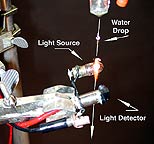 The set-up for splash photography generally involves having a method for producing droplets at a regular rate and a reservoir of liquid to generate drops over an extended period of time. The liquid in a container is firmly held some distance above the desired impact zone.
The set-up for splash photography generally involves having a method for producing droplets at a regular rate and a reservoir of liquid to generate drops over an extended period of time. The liquid in a container is firmly held some distance above the desired impact zone.
A small light and a light sensor are placed below the liquid container in such a manner that the droplets will pass between them as the fall to the liquid pool below. When a droplet interrupts the light beam a signal is detected by the synchronizer and it starts to "time out" for the time selected on the variable time delay function of the synchronizer. When the preselected time has passed the flash, connected to it, is triggered. If at the time the flash fires the drop is seen to be above the impact area then more time is added to the delay function and if it happens too late then some time is taken off the controller. This process can be simply done visually.
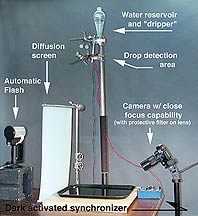 When the desired effect is seen the camera shutter, placed on "B", is opened just prior to a drop leaving the dropper and closed immediately after the flash goes off. The film is then advanced and one is ready to repeat the process as no two splashes are identical in appearance although one may be making the photograhs exactly at the same time in the lifetime of each splash. It helps if the camera has a built-in motorized film advance. This will prevent disturbing the camera position and also encourage the making of many photographs!
When the desired effect is seen the camera shutter, placed on "B", is opened just prior to a drop leaving the dropper and closed immediately after the flash goes off. The film is then advanced and one is ready to repeat the process as no two splashes are identical in appearance although one may be making the photograhs exactly at the same time in the lifetime of each splash. It helps if the camera has a built-in motorized film advance. This will prevent disturbing the camera position and also encourage the making of many photographs!
Needless to say, the photographs need to be made in an environment where the light level can be reduced to a level such that keeping the shutter open for a brief time will not cause any fogging exposure on film or on a digital camera's sensor.
Once the "technical" details of controlling the splashes and the time at which the action stopping flash of light of the electronic flash happens it is then possibly to concentrate on the other aspects of the picture-making process. It is my suggestion that one must pay attention to such things as lighting and angle from which the photographs are taken, the choice of liquid, drop distance and other factors in order to end up with a final image that is not only successful on a technical level but also an aesthetic one. I believe that although Harold Edgerton took many impressive splash photographs and others have as well, the ultimate splash photograph has yet to be made. Splashes provide a most interesting and rewarding photographic challenge.
Ultimately the best way to make effective splash photographs is to jump in and
immerse yourself into the process.
Happy splashing!, Andy Davidhazy
If you want to send me an email use this address: andpph@rit.edu
Manufacturers of commercial synchronizers and time delay units:
The Wave Sensor, is a multifaceted synchronizer made by LPA Design and includes delay
capabilty as well light, sound and dark activation ...
much like the device described above but digital and probably much more reliable! You can get
it from: http://www.lpadesign.com/
The Kapture Group makes a very sophisticated sync system including detectors, synchronizers and delay timers, etc.
Find them at: http://www.kapturegroup.com/kap_htmls/laser.html
You can also obtain similar devices starting with the Shutter Beam from:
Woods Electronics
c/o Steve Yankey
619-486-0806
Web: Woods Electronics- Sound and IR activated synchronizers
The schematic, PC board, parts list and rudimentary
instructions of the Dark activated Synchronizer with Delay that I used for this project are available on the web
at the following address:
text-flying-bird.html
|



